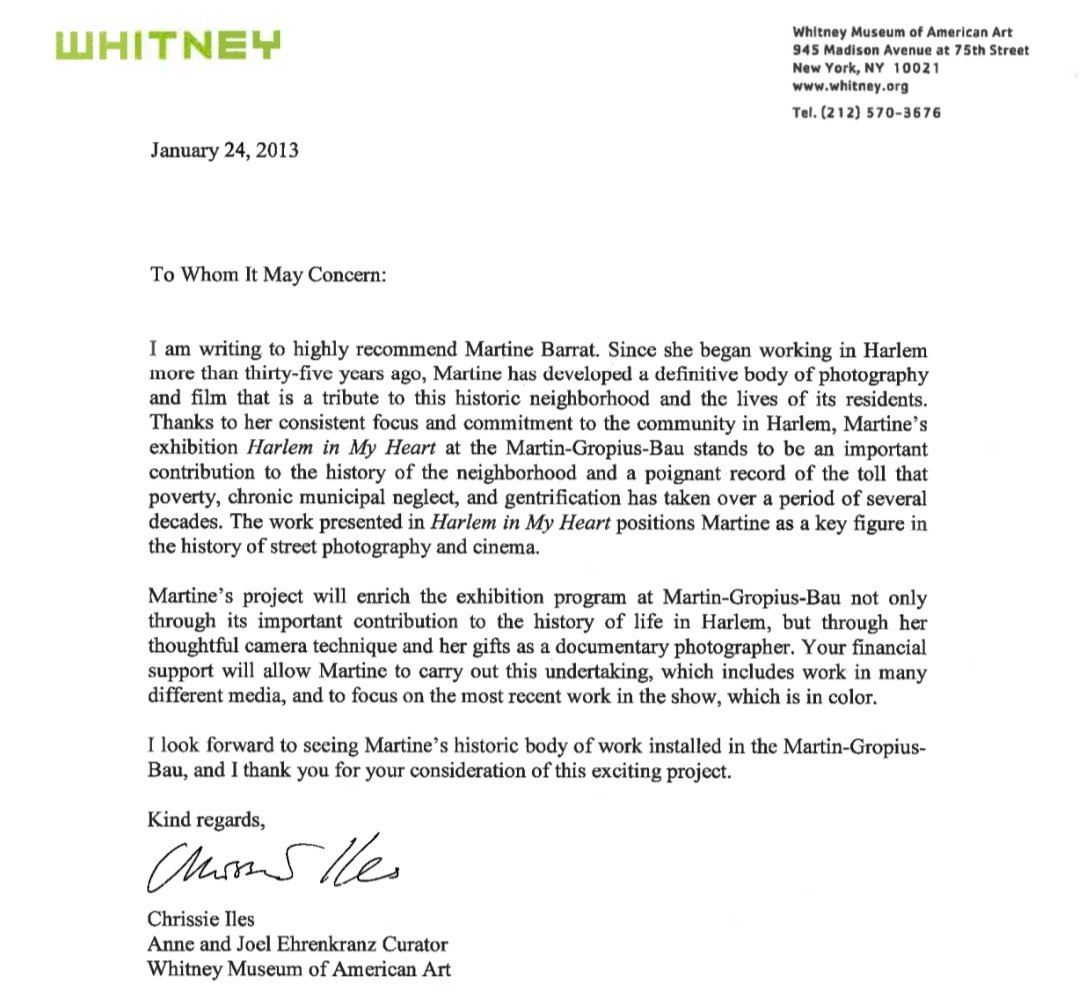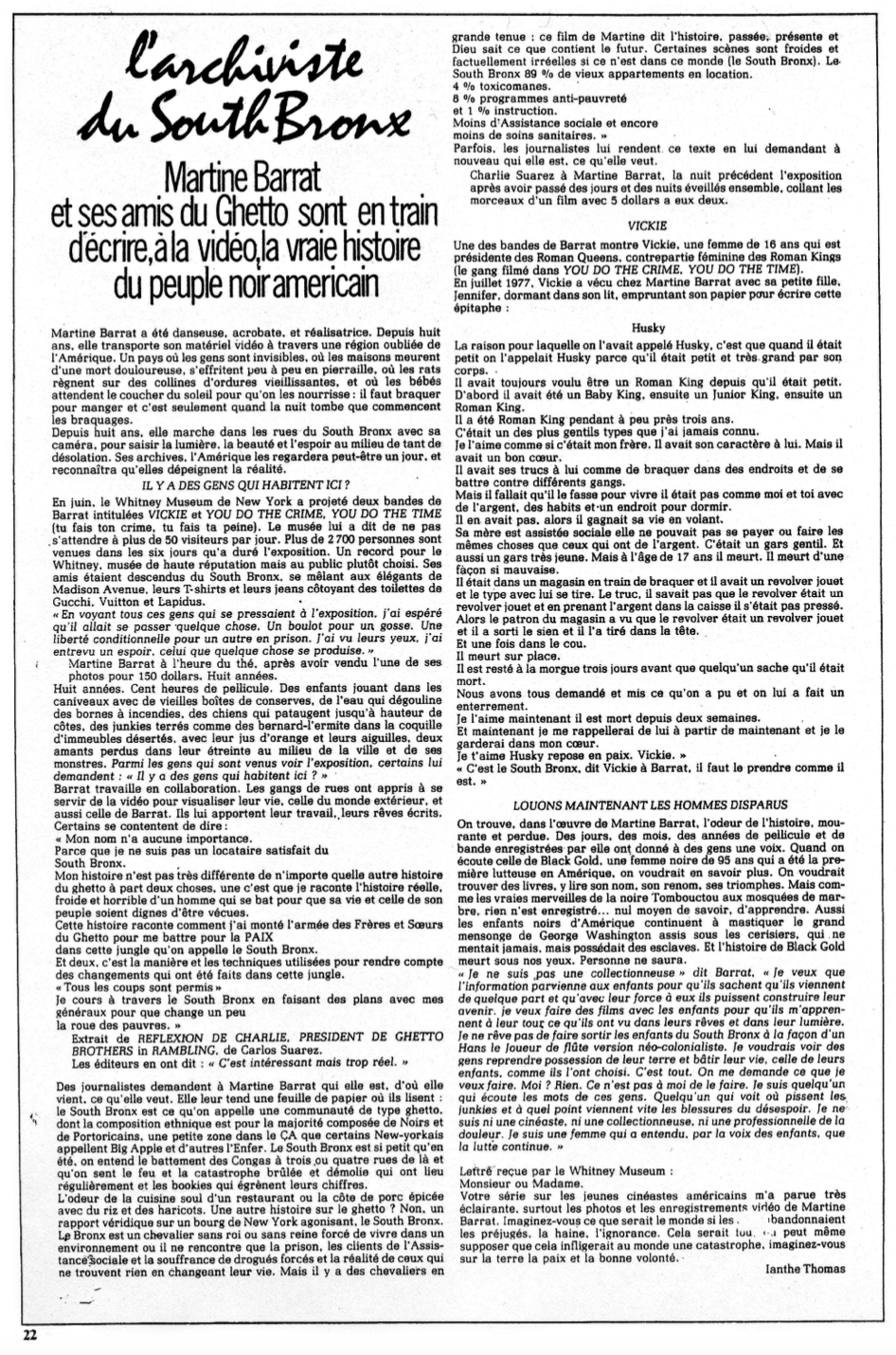THE WHITNEY MUSEUM
March 14. 2014
To whom it may concern,
Martine Barrat is a highly important figure in the history of photography and film in New York and America. Since she began working in Harlem more than thirty-five years ago, she has developed a definitive body of photography and film that is a tribute to this historic neighborhood and the lives of its residents. Her consistent focus and commitment to the community in Harlem has produced a very important contribution to the area's history, and a poignant record of the toll that poverty, chronic municipal neglect, and gentrification has taken over a period of several decades. Barratt's powerful photographs and films position her as a key figure in the history of street photography and cinema.
January 24, 2013
To Whom It May Concern:
I am writing to highly recommend Martine Barrat. Since she began working in Harlem more than thirty-five years ago, Martine has developed a definitive body of photography and film that is a tribute to this historic neighborhood and the lives of its residents. Thanks to her consistent focus and commitment to the community in Harlem, Martine's exhibition Harlem in My Heart at the Martin-Gropius-Bau stands to be an important contribution to the history of the neighborhood and a poignant record of the toll that poverty, chronic municipal neglect, and gentrification has taken over a period of several decades. The work presented in Harlem in My Heart positions Martine as a key figure in the history of street photography and cinema. Martine's project will enrich the exhibition program at Martin-Gropius-Bau not onlv through its important contribution to the history of life in Harlem, but through her thoughtful camera technique and her gifts as a documentary photographer. Your financial support will allow Martine to carry out this undertaking, which includes work in many different media, and to focus on the most recent work in the show, which is in color. I look forward to seeing Martine's historic body of work installed in the Martin-Gropius-Bau, and I thank you for your consideration of this exciting project.
MARTINE BARRAT'S VIDEOTAPES FROM SOUTH BRONX AT WHITNEY
A selection of videotapes by Martine Barrat, who has been working with street gangs in the South Bronx since 1971, will be presented trom Tuesday, June 6 through Sunday, June 11, as part of the Whitney Museum's New American Filmmakers Series. Martine Barrat first began to work with video and young people on the Lower East Side in space provided by Ellen Stewart of La Mama E.T.C., and in collaboration with jazz musicians Charles (Bobo) Shaw, Joseph Bowie, and Lester Bowie of the Human Arts Ensemble. She subsequently worked in Harlem and then in the South Bronx, where she taught the use of video to street gang members. The result is more than 100 hours of videotape made in collaboration with members of the Roman Kings, Roman Queens, and other gangs. Unlike most attempts to document on film or television the life of neighborhoods like the South Bronx, Barrat's work emerged from an intense and daily relationship which spanned years. "They were my teachers as much as I was theirs, Barrat says of the young people with whom she worked. The exhibition includes footage shot while riding through the neighborhood, as well as two longer tapes. YOU DO THE CRIME YOU DO THE TIME is a 30-minute tape of the trial by his peers of a 12 1/2-year-old member of the Roman Kings who violated the gang's rules by robbing an old woman in front of the gang's headquarters. Shot in the clubhouse, the tape presents the gang's codes of honor and justice and how those codes operate. VICKIE is a sustained reflection on her life--her marriage, her time in prison, the death of close friends, etc.--by the then-16-year-old president of the Roman Queens. Speaking of the South Bronx project as a whole, Barrat has written "In these tapes, I encouraged members of the gangs to use the video camera as a kind of moving pencil to sketch the reality of their lives and relationships with one another and with the outside world. The camera in their hands is often a blunt instrument, but it seems to have a unique power to express the truth of their lives as they see them. Originally involved in theater as a dancer, actress, acrobat, costume designer, and stage designer, Martine Barrat now concentrates on video, film, and photography She is Video Artist-in-Residence and Video Coordinator for TIWITAS--La Mama E.I.C.'s Third World Institute of Theater Art Studies. Her video work is funded in part by the New York State Council on the Arts. Her work in the South Bronx has been shown on NBC Television's special "Violence in America"; at Columbia University's "Schizo-Culture" conference (her work has been of great interest to radical therapists such as Felix Guattari and David Cooper); at the Centre National d’Art : et de Culture Georges Pompidou, Paris; and at many showings to South Bronx gangs and their families. Martine Barrat's videotapes will be shown Tuesday through Friday at 3, 4:30, 6, and 7:30; Saturday and Sunday at 12, 1:30, 3, and 4:30. The New American Filmmakers Series is assisted with funds from the Jerome Foundation and the National Endowment for the Arts.



